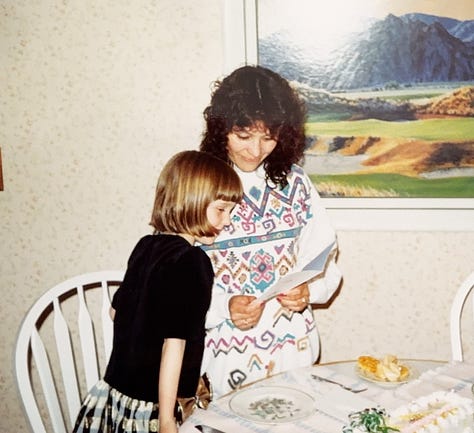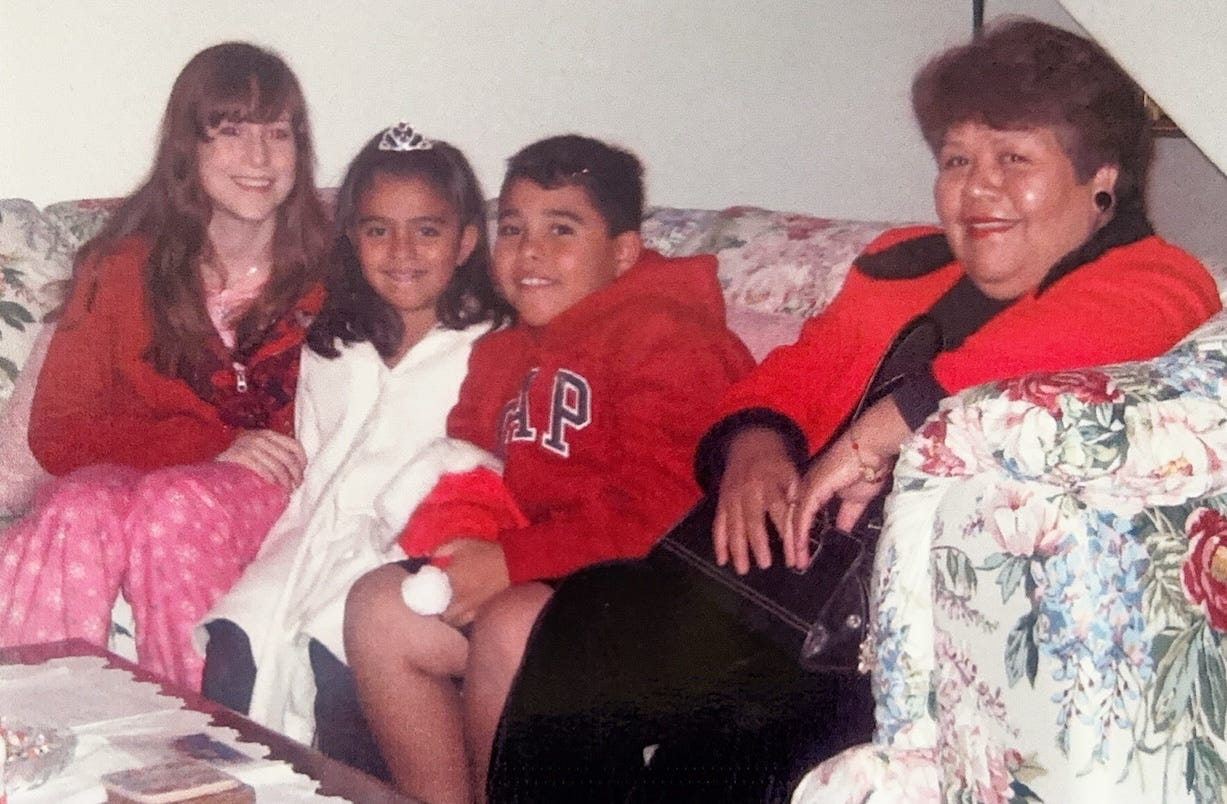It’s been quite a week down in my hometown of Los Angeles. ICE is needlessly tearing families apart at the behest of known white supremacist goblin/human E.coli sample Stephen Miller, and now Chief Tangerine Numbnuts has called in the National Guard to terrorize and maim protesters. Nearly a thousand miles away, I breathe in completely clean air, untarnished by toxic tear gas fumes1. Yet emotionally, I feel tied by an invisible string to all of those down there fighting for their beloved community, fighting for people who are far more indigenous to this land than I am2, and certainly far more native to this land than any frightening, deeply sunburned, MAGA-cult white supremacists wearing Oakleys in their social media avatar.3 (WHY are they always so sunburned?? Why do all of them comically wear awful-looking Oakleys???) But more than anything else, I feel immense gratitude and pride for having been partially raised by two Latina women, immigrants themselves who forever changed me for the better.
With both parents working demanding, full-time corporate jobs, childcare was absolutely essential in my household. My parents eventually connected with Violeta through an agency, and she quickly became a major extension of our family. From when I was a toddler up to 8 years old, Violeta, an immigrant from Guatemala, watched over me, briefly lived with us for a few years, and cared for me with a level of love and tenderness only paralleled by my own parents and grandparents. (You can get a taste of it from the video above, where I’m playing a keyboard she got me for my 2nd birthday). Through Violeta, I picked up my first few bits of Spanish. Pequeñita bonita. Chiquita linda. Muchachita. Muñequita.



Some of my earliest memories are of being with her and my parents in the kitchen of our first house in Chatsworth, sloppily eating corn at the table, then flashes of her chopping scallions at what would be my permanent childhood home in Porter Ranch. While recently rifling through childhood memorabilia, I found an old document that included a note about how “attached I was to the babysitter,” as if that was something abnormal. Looking back, I felt Violeta uniquely understood and intuitively knew how to engage me, even though I wasn’t the most talkative kid, even when I struggled to pick up or respond to certain social cues in my first five years. When kids feel seen and understood, attachment only grows.
When she wasn’t living with us, she resided with her siblings’ family in Van Nuys. I would sometimes tag along with her, driving back and forth across the Valley. I have fond memories of playing with Violeta’s nieces, Naomi and Brendy, during occasional sleepovers. We’d wake up the next morning and either play or laze around, eventually running outside to flag down the street vendor for duritos, a criminally underexposed and underrated snack outside of Latiné culture: crispy, puffed wheat chips drenched in lime juice and chili seasoning in the shape of a wheel. I thought it was one of the best things I had ever tasted (still do, actually), eventually matched only by Martha’s homemade pozolé and my trashy eternal love of Cup Noodles with “salsa picanté” flavoring.
Around 6 or 7, I remember first hearing the singular and angelic voice of Selena, a young Mexican-American singer who had recently skyrocketed to mainstream fame, on the Spanish radio station that Violeta played while driving me to and fro. I had heard “Amor Prohibido,” “Bidi Bidi Bom Bom” and other catchy tunes before, but “Como la Flor” was the first single of hers that truly stuck with me. It would become widely known as Selena’s signature song.
Como la flor con tanto amor
Me diste tú, se marchitó
Me marcho hoy, yo sé perder
Pero, ah-ah-ay, ¡cómo me duele!
Cruelly, Selena was taken from us just as I was first getting to know her and her incredible music. I remember the week of her death well: I was about to turn 7 years old, and the Spanish-speaking radio host sounded somber, almost tearful in tone; a grievous aura hanging over everything as I heard Violeta sniffling in response. As a kid, I wasn’t yet so accustomed to the idea of death beyond Disney films, but this was one of the first very public tragedies that I understood. The radio host introduced “Como la Flor” once again, Selena’s bright vocals streaming through the car. This time, the song had a different gravity and finality to it.
Before she left for a new job opportunity, Violeta connected my family with Martha, who took on the mantle of picking me up from school, looking after me on weekday afternoons and shuttling me to various extracurricular activities. At 8 years old, I found myself feeling disrupted by this sudden change, in addition to having recently been told that my parents were separating. I gave Martha a bit of a hard time at first, sizing her up in a guarded way, maybe wondering deep down how anyone could possibly match up to my bond with Violeta. How completely wrong I was. One of my first core memories with Martha was when we went to see the 1997 film Selena together. We both laughed and cried, snacking on cheesy, pickled jalapeño-topped nachos and sipping on Icees, and I began to feel my defensive walls coming down, feeling my ability to trust and let somebody new in, just as my familial world was permanently transforming; my dad gearing up to move out into his own apartment. At 8, I found myself benefitting from Martha’s presence not only as a caregiver, but as a true friend and secondary mother figure.
Over the years, Martha and I grew incredibly close. I’m pretty sure she loved Barbies even more than I did, which the two of us often played with together during my younger years. As trust continued to build between us, she shared with me both beautiful and harrowing stories of her childhood and early adulthood. She grew up with several brothers and sisters in Mexico City, and as a young adult had tense run-ins with immigration officers, once sprinting as quickly as possible past the border while being tracked down by a helicopter, making several attempts to leave her hometown of Mexico City before finally succeeding and making it to Los Angeles in her 20’s. There, she met the love of her life, Hilario, who had immigrated there from Michoacán. I got to know him as well; a playful soul who played tío and segundo papá to their many nieces and nephews, and eventually became something of a father/uncle figure for me as well, teaching me how to play Super Mario World on Super Nintendo. He often called me güera, ritualistically teased and tickled me to the point of frustration, and introduced me to the Mexican cake-biting phenomenon of la mordida on my 11th birthday, as seen below. As I felt his hand shove my face into the birthday cake they got for me, I was shocked, even angry for a few seconds, but was soon involuntarily laughing so hard I couldn’t even breathe. Family will do that to you sometimes. And Martha’s family very much became my own, including her sister Dolores aka Lolis, brother-in-law Luis, her nieces Fanny and Erica, and her nephew Luis.
During my last year of elementary school, Martha’s niece Fanny gave birth to a son, Byron. Byron and I were both early April babies, him only 10 years younger than I. Doesma followed only a couple years later, named for her mother Dolores, grandmother Esther (Martha’s mother), and aunt Martha. For a time, Byron and Doesma were much like cousins to me. I remember meeting Doesma the day she was born in the hospital; she was the first newborn I ever held. At nearly 13, holding her in my hands, I felt the weight and responsibility of handling this new little bundled up blob of a human, along with the innate trust that both Martha and Fanny generously granted me in that moment. I would always be excited to see Byron and Doesma in the backseat at some of my school pickups, sometimes followed by a fast food pit stop. But more than any McDonald’s crispy chicken sandwich or Jack in the Box curly fries, I fell in love with Martha’s pozole rojo, made from scratch with chiles, pork, and hominy; complemented by crunchy slaw, radish, lime and a tostada on the side. As a foodie and texture girl since day one, I would often spread Mexican crema all over the tostada before soaking it in the broth and breaking it up into pieces for a crunchy added garnish. I could often eat at least 2 bowls of it, sometimes more. Martha made it primarily for special occasions, but she would also kindly make it at my request.
My years with Martha are some of the fondest of my entire childhood. She truly looked after and cared for me as if I was one of her own children, and was endlessly generous with her time and many gifts. She would let me in on certain bits of her own family troubles, just as I would vent to her about my own family tensions, struggles with friends, or boy drama. She always gave me a supportive ear, but never hesitated to let me know when I was acting out of turn or behaving poorly. She knew what it meant to love someone fully, which means you can treat them with tenderness, but can also hold them accountable. “You are being so selfish,” she told me once in my early teenage years, after I had complained about my mom being hard on me about my grades. “You don’t realize how much your mom does for you—someday you will.” She was right.
What’s more is that Martha and her family truly introduced me to Mexican culture, embracing me with open arms, and allowing me to participate in their customs, including religiously watching telenovelas like Ramona. She and her family would mostly speak Spanish at home, which meant I started to pick up on various bits of Mexican slang. No manches. Andale, güey. Pinche cabron. Pendejo. Chismosa. ¡Eres una chingona! Along with these fun new slang terms I was learning, I also started picking up on the unique challenges that Martha and her family members carried on their shoulders as Mexican immigrants in the United States. Many of Martha’s family members worked tough service jobs, making it all work through grit, tenacity and a healthy sense of humor. Martha once poked fun at her nephew Luis, who once came home with Panda Express takeout, eating it with tortilla chips that he squeezed into the takeout box. “Híjole, fuckin’ Mexicans!” she said, laughing. Their collective spirit was such that even when they didn’t have much, it was somehow always enough. Certainly enough that they were always benevolent, among the most effortlessly giving people I’ve ever been around—and if I’m being honest, much more so than folks on the more affluent side of my own biological family tree.
I’ve been thinking a lot of Martha and Violeta lately, along with plenty of others and their families who are likely experiencing lots of PTSD and current trauma at the thought of being suddenly separated or deported from their loved ones. Many immigrant families contain a mixture of fully naturalized citizens, some born here in the United States, while others may still be undocumented. These situations are complex, and judgment or prejudice about them is simply an ignorant waste of time. As a born-and-raised second-generation Angeleno, I’ve long been clear on the fact that Los Angeles is a city of immigrants and of differences that should bridge us all together more than they tear us apart.
I want to wrap up by sharing some organizations that are doing important work that’s worth looking into. If you have the means, please support them by spreading the word on social media about their reporting, and/or throw them some funds to help them continue their mission.














This was incredible. Thank you for sharing.